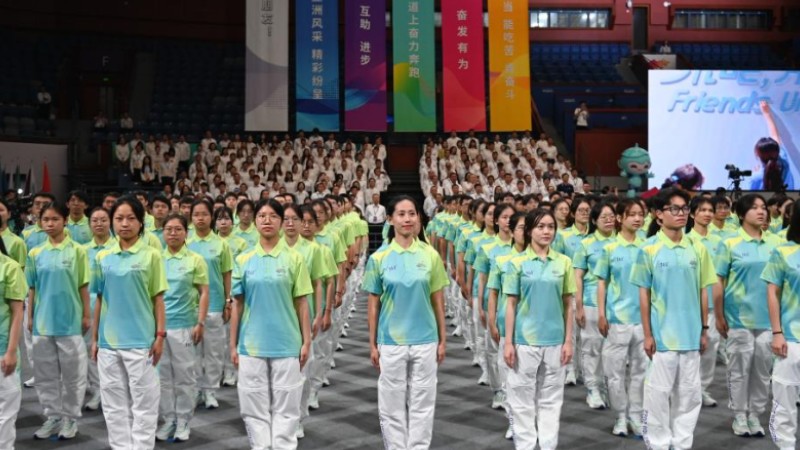China, India has vast room for cooperation in lunar exploration under BRICS, SCO mechanisms
The fourth to join the lunar-landing club and the first to land near the moon's south pole, India's Chandrayaan-3spacecraft notched a historic milestone on Wednesday as it softly touched down on the lunar surface, drawing enthusiastic applause from stargazers across the world.
Chinese experts hailed the feat as representing the growing significance of developing countries in space and called for India to abandon involving geopolitical schemes in the pursuit of scientific advancement, as the spirit of science transcends national boundaries and should be pursued in collaboration with players worldwide.
A small, solar-powered rover called Pragyanis expected to roll off the lander and spend one lunar day (about 14 Earth days) exploring its new home, with the goal of collecting scientific data about the moon's makeup, CNN reported.
"This success belongs to all of humanity and it will help moon missions by other countries in the future," Indian Prime Minister Narendra Modi, who is currently in South Africa for the BRICS Summit, said in a speech on livestream.
Chinese experts reached by the Global Times expressed their sincere congratulations on Wednesday, saying that given the two countries are both emerging economies and member states of BRICS and the Shanghai Cooperation Organization, there is vast room for cooperation between the two sides both in deep-space exploration and manned missions, such as data sharing, experience sharing and astronaut training.
"The spirit of science transcends national boundaries, as it ultimately strives for the well-being and progress of all humanity. We appreciate every effort in this course, regardless of whether it's successful," Hu Shisheng, director of the Institute for South Asian Studies at the China Institutes of Contemporary International Relations, said on Thursday.
Landing on the moon is a challenging endeavor. Only a few days ago, Russia's Luna-25probe crashed into the moon, ending the country's first such attempt in half a century. India's first attempt at a lunar touchdown also failed in September 2019.
The lunar south pole has remained a largely uncharted region of immense interest to scientists worldwide, as it is believed to harbor large amounts of water ice, which, if accessible, could be mined for rocket fuel and life support for future crewed missions, according to space.com.
China is also eyeing the region as it presses ahead with its lunar exploration project. The Chang'e-7mission is intended to land on the moon's south pole around 2026 and conduct detailed surveys to explore for traces of water, according to the program's chief designer.
Around 2028, the basic structure of International Lunar Research Station co-built by China and Russia will be completed at the south pole region with the launch of the Chang'e-8mission.
Comparing Chinese tech with the Indian side, Pang Zhihao, a Beijing-based senior space expert, told the Global Times on Thursday that China is far more advanced in various aspects. For one thing, China has been capable of sending orbiters and landers directly into Earth-Moon transfer orbit since the launch of Chang'e-2in 2010, a maneuver that India has yet to deliver given the limited capacity of its launch vehicles. Therefore, China's technology has allowed moon missions to save a significant amount of time and fuel. The engine that China used is also far more advanced, as it can vary its thrust from 1,500 to 7,500 Newtons.
Furthermore, China's lunar rover is much bigger, weighing 140 kilograms compared to India's 26 kilograms, Pang noted. Additionally, India's Pragyancannot withstand the lunar nights and has a lifespan of only one lunar day. By contrast, China's Yutu-2rover holds the record for working the longest time on the lunar surface, as it is equipped with nuclear power, allowing for long-duration operations.
While China has opened its arms to embrace all interested parties to join the country's space program and has received large amounts of applications from across the world, geopolitical factors have emerged to hinder such cooperation.
In a recent exclusive interview, the Global Times learned from a project manager from India that their project, which was expected to be the first international payload to go to the China Space Station, has hit a roadblock with the key equipment produced by India waiting for export clearance from the Indian Ministry of External Affairs indefinitely.
Photos
Related Stories
- Xi talks with Modi on ties
- Wang Yi calls for efforts to improve China-India relations
- "Chinese Bridge" language competition promotes China-India exchanges: Chinese diplomat
- Xi extends condolences to Indian president, PM over deadly train accident
- Peace, unity high on FM's agenda in India
- Chinese FM calls for joint efforts with India to bring ties back to stable development
- Chinese FM calls on youths to contribute to China-India cooperation, friendship
- What does 18th China-India Corps Commander Level Meeting indicate?
- Air cargo route from China's Ezhou to India's Delhi opens
- Indian youth attend Tiangong Dialogue with Chinese taikonauts
Copyright © 2023 People's Daily Online. All Rights Reserved.









